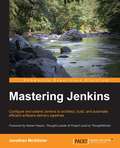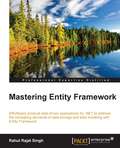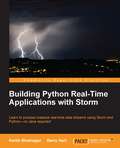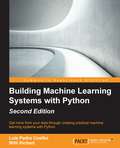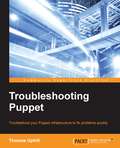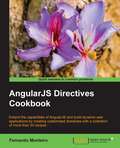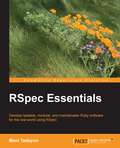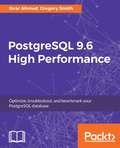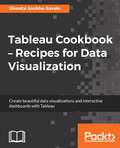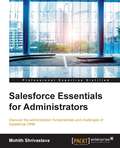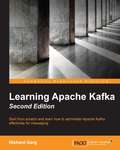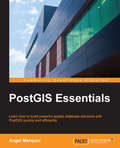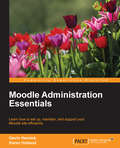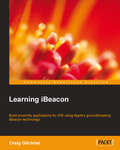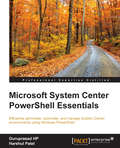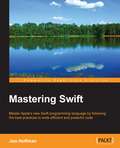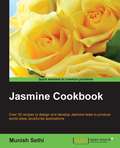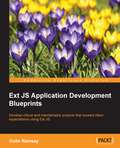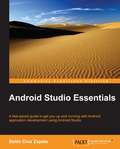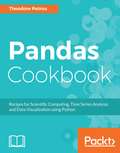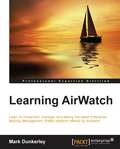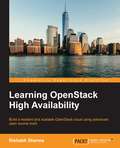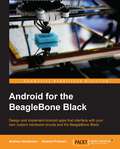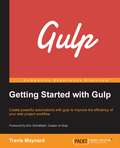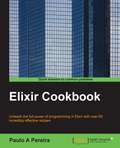- Table View
- List View
Mastering Jenkins
by Jonathan McallisterConfigure and extend Jenkins to architect, build, and automate efficient software delivery pipelinesAbout This BookConfigure and horizontally scale a Jenkins installation to support a development organization of any sizeImplement Continuous Integration, Continuous Delivery, and Continuous Deployment solutions in JenkinsA step-by-step guide to help you get the most out of the powerful automation orchestration platform that is JenkinsWho This Book Is ForIf you are a novice or intermediate-level Jenkins user who has used Jenkins before but are not familiar with architecting solutions and implementing it in your organization, then this is the book for you. A basic understanding of the core elements of Jenkins is required to make the best use of this book.What You Will LearnCreate and manage various types of build jobs, and implement automation tasks to support a software project of any kindGet to grips with the automated testing architecture, and scalable automated testing techniquesFacilitate the delivery of software across the SDLC by creating scalable automated deployment solutionsManage scalable automation pipelines in Jenkins using the latest build, test, and deployment strategiesImplement a scalable master / slave build automation platform, which can support Windows, Mac OSX, and Linux software solutionsCover troubleshooting and advanced configuration techniques for Jenkins slave nodesSupport a robust build and delivery system by implementing basic infrastructure as code solutions in configuration management tools such as AnsibleIn DetailWith the software industry becoming more and more competitive, organizations are now integrating delivery automation and automated quality assurance practices into their business model. Jenkins represents a complete automation orchestration system, and can help converge once segregated groups into a cohesive product development and delivery team. By mastering the Jenkins platform and learning to architect and implement Continuous Integration, Continuous Delivery, and Continuous Deployment solutions, your organization can learn to outmanoeuvre and outpace the competition.This book will equip you with the best practices to implement advanced continuous delivery and deployment systems in Jenkins. The book begins with giving you high-level architectural fundamentals surrounding Jenkins and Continuous Integration. You will cover the different installation scenarios for Jenkins, and see how to install it as a service, as well as the advanced XML configurations. Then, you will proceed to learn more about the architecture and implementation of the Jenkins Master/Save node system, followed by creating and managing Jenkins build jobs effectively. Furthermore, you'll explore Jenkins as an automation orchestration system, followed by implementing advanced automated testing techniques. The final chapters describe in depth the common integrations to Jenkins from third-party tools such as Jira, Artifactory, Amazon EC2, and getting the most out of the Jenkins REST-based API.By the end of this book, you will have all the knowledge necessary to be the definitive resource for managing and implementing advanced Jenkins automation solutions for your organization.Style and approachThis book is a step-by-step guide to architecting and implementing automated build solutions, automated testing practices, and automated delivery methodologies. The topics covered are based on industry-proven techniques, and are explained in a simple and easy to understand manner.
Mastering Entity Framework
by Rahul Rajat SinghThis book is for .NET developers who are developing data-driven applications using ADO.NET or other data access technologies. This book is going to give you everything you need to effectively develop and manage data-driven applications using Entity Framework.
Building Python Real-Time Applications with Storm
by Barry Hart Kartik BhatnagarLearn to process massive real-time data streams using Storm and Python--no Java required! About This Book * Learn to use Apache Storm and the Python Petrel library to build distributed applications that process large streams of data * Explore sample applications in real-time and analyze them in the popular NoSQL databases MongoDB and Redis * Discover how to apply software development best practices to improve performance, productivity, and quality in your Storm projects Who This Book Is For This book is intended for Python developers who want to benefit from Storm's real-time data processing capabilities. If you are new to Python, you'll benefit from the attention to key supporting tools and techniques such as automated testing, virtual environments, and logging. If you're an experienced Python developer, you'll appreciate the thorough and detailed examples What You Will Learn * Install Storm and learn about the prerequisites * Get to know the components of a Storm topology and how to control the flow of data between them * Ingest Twitter data directly into Storm * Use Storm with MongoDB and Redis * Build topologies and run them in Storm * Use an interactive graphical debugger to debug your topology as it's running in Storm * Test your topology components outside of Storm * Configure your topology using YAML In Detail Big data is a trending concept that everyone wants to learn about. With its ability to process all kinds of data in real time, Storm is an important addition to your big data "bag of tricks." At the same time, Python is one of the fastest-growing programming languages today. It has become a top choice for both data science and everyday application development. Together, Storm and Python enable you to build and deploy real-time big data applications quickly and easily. You will begin with some basic command tutorials to set up storm and learn about its configurations in detail. You will then go through the requirement scenarios to create a Storm cluster. Next, you'll be provided with an overview of Petrel, followed by an example of Twitter topology and persistence using Redis and MongoDB. Finally, you will build a production-quality Storm topology using development best practices. Style and approach This book takes an easy-to-follow and a practical approach to help you understand all the concepts related to Storm and Python.
Building Machine Learning Systems with Python - Second Edition
by Luis Pedro Coelho Willi RichertThis book primarily targets Python developers who want to learn and use Python's machine learning capabilities and gain valuable insights from data to develop effective solutions for business problems.
Troubleshooting Puppet
by Thomas UphillTroubleshoot your Puppet infrastructure to leverage your system's performance effectively About This Book * Covers major tools in Puppet deployment * Fix catalog compilation problems and deal with issues found in larger deployments, such as scaling and improving performance. * A fast-paced guide with real-world examples Who This Book Is For If you are a beginner to intermediate Puppet Engineer looking for guidance to help fix problems with your Puppet deployments, this book is for you. What You Will Learn * Debug your Puppet infrastructure * Use APIs to ensure services are working properly * Fix catalog compilation issues * Solve problems using Hiera tool * Detect problems in your environment using PuppetDB tool * Learn ways to format code to aid in identifying errors * Troubleshoot errors in modules and templates In Detail Puppet is a configuration management system written for system administrators to manage a large number of systems efficiently and help maintain order. Deploying Puppet becomes more complex as you increase the number of nodes in your environment. The Puppet tool is an intelligent solution that increases the automation footprint for the proactive management of server infrastructures. Puppet's simple programming language is usable on most operating systems and is portable on different deployment environments. We begin by looking at the puppet.conf server configuration file, and talk about possible problems that can occur. What does puppet really do in the background and what options does it provide for troubleshooting? This is what we will explore. Moving on, we will be troubleshooting errors made in modules and templates, finding the best solutions. We will be writing code that will helping us in identify errors. Then we will explain how several ENCs do their job and how puppet communicates with them. We will learn how PuppetDB collects data generated by Puppet. It also enables advanced Puppet features like exported resources, and can be the foundation for other applications that use Puppet's data. By the end of the book we will have learned the best debugging tips for Puppet and PuppetServer. Style and approach This is a quick-paced guide packed with real-world examples and solutions to obstacles in your Puppet infrastructure.
AngularJS Directives Cookbook
by Fernando MonteiroExtend the capabilities of AngularJS and build dynamic web applications by creating customized directives with this selection of more than 30 recipes About This Book * Learn how to extend HTML templates in new ways to build even better web applications with exceptional interface components * Build reusable directives for large-scale AngularJS applications * Create even sophisticated and impressive modern web apps with ease Who This Book Is For This book is for developers with AngularJS experience who want to extend their knowledge to create or customize directives in any type of AngularJS application. Some experience of modern tools such as Yeoman and Bower would be helpful, but is not a requirement. What You Will Learn * Build and customize external HTML templates, and create simple, effective directives for common interface components * Learn how to use Controller function and any Bootstrap UI directives to manipulate the DOM and how to transform any UI library into AngularJS directives * Construct an AngularJS application to use shared components and validate your HTML5 * Discover how to use jQuery events and manipulate the DOM using jQuery UI inside AngularJS applications * Create custom directives for ongoing projects using Yeoman generators, and find out how to implement standalone directives * Build reusable directives for Large AngularJS applications and extend directives to use dynamic templates * Write unit test for directives using the Karma runner and Jasmine's behavior-driven development framework In Detail AngularJS directives are at the center of what makes it such an exciting - and important - web development framework. With directives, you can take greater control over HTML elements on your web pages - they 'direct' Angular's HTML compiler to behave in the way you want it to. It makes building modern web applications a much more expressive experience, and allows you to focus more closely on improving the way that user interaction impacts the DOM and the way your app manages data. If you're already using Angular, you probably recognize the power of directives to transform the way you understand and build your projects - but customizing and creating your own directives to harness AngularJS to its full potential can be more challenging. This cookbook shows you how to do just that - it's a valuable resource that demonstrates how to use directives at every stage in the workflow. Packed with an extensive range of solutions and tips that AngularJS developers shouldn't do without, you'll find out how to make the most of directives. You'll find recipes demonstrating how to build a number of different user interface components with directives, so you can take complete control over how users interact with your application. You'll also learn how directives can simplify the way you work by creating reusable directives - by customizing them with Yeoman you can be confident that you're application has the robust architecture that forms the bedrock of the best user experiences. You'll also find recipes that will help you learn how to unit test directives, so you can be confident in the reliability and performance of your application. Whether you're looking for guidance to dive deeper into AngularJS directives, or you want a reliable resource, relevant to today's web development challenges, AngularJS Directives Cookbook delivers everything you need in an easily accessible way. Style and approach This book easy-to-follow guide is packed with hands-on recipes to help you build modular AngularJS applications with custom directives. It presents tips on using the best tools and various ways to use these tools for front-end development.
RSpec Essentials
by Mani TadayonDevelop testable, modular, and maintainable Ruby software for the real world using RSpec About This Book * Explore the concept of testability and how to implement tests that deliver the most value * Maximize the quality of your Ruby code through a wide variety of tests * Master the real-world tradeoffs of testing through detailed examples supported by in-depth discussion Who This Book Is For This book is aimed at the software engineer who wants to make their code more reliable and their development process easier. It is also aimed at test engineers who need to automate the testing of complex systems. Knowledge of Ruby is helpful, but even someone new to the language should find it easy to follow the code and tests. What You Will Learn * Identify a unit of software for the purposes of testing * Manage test states with hooks, fixtures, and mocks * Handle external web services in tests using various techniques * Configure RSpec flexibly and cleanly using support code and environment variables * Interact with rich web apps in tests using Capybara * Build the right feature with behavior-driven development * Customize matchers and failure messages * Verify correct development and production environments In Detail This book will teach you how to use RSpec to write high-value tests for real-world code. We start with the key concepts of the unit and testability, followed by hands-on exploration of key features. From the beginning, we learn how to integrate tests into the overall development process to help create high-quality code, avoiding the dangers of testing for its own sake. We build up sample applications and their corresponding tests step by step, from simple beginnings to more sophisticated versions that include databases and external web services. We devote three chapters to web applications with rich JavaScript user interfaces, building one from the ground up using behavior-driven development (BDD) and test-driven development (TDD). The code examples are detailed enough to be realistic while simple enough to be easily understood. Testing concepts, development methodologies, and engineering tradeoffs are discussed in detail as they arise. This approach is designed to foster the reader's ability to make well-informed decisions on their own. Style and approach This comprehensive tutorial is packed with real-world examples of testing with RSpec. The most important features of RSpec are introduced in the early chapters and are used in examples of growing complexity in the following chapters. Concepts and methodologies are discussed in detail.
B03602_PostgreSQL High Performance
by Packt Publishing<P><P>Enhance the performance of your PostgreSQL system with this handy guide while avoiding common pitfalls that can slow it down. <P><P>Key Features <P><P>Learn the right techniques to obtain optimal PostgreSQL database performance, ranging from initial design to routine maintenance <P><P>Fine tune the performance of your queries and avoid the common pitfalls that can slow your system down <P><P>Contains tips and tricks on scaling successful database installations, and ensuring a highly available PostgreSQL solution <P><P>Book Description <P><P>Database administrators and developers spend years learning techniques to configure their PostgreSQL database servers for optimal performance, mostly when they encounter performance issues. Scalability and high availability of the database solution is equally important these days. This book will show you how to configure new database installations and optimize existing database server installations using PostgreSQL 9.6. <P><P>You will start with the basic concepts of database performance, because all successful database applications are destined to eventually run into issues when scaling up their performance. You will not only learn to optimize your database and queries for optimal performance, but also detect the real performance bottlenecks using PostgreSQL tools and some external tools. Next, you will learn how to benchmark your hardware and tune your operating system. Optimize your queries against the database with the help of right indexes, and monitor every layer, ranging from hardware to queries. Moving on, you will see how connection pooling, caching, partitioning, and replication will help you handle increasing database workloads. <P><P>Achieving high database performance is not easy, but you can learn it by using the right guide-PostgreSQL 9.6 High Performance. <P><P>What you will learn <P><P>Learn the best practices to configure your PostgreSQL 9.6 database for optimal performance <P><P>Write optimal queries and techniques to detect performance issue in queries <P><P>Fine tune the performance of your queries using benchmarking and indexing techniques <P><P>Ensure high performance and a highly available database using the scaling and replication techniques <P><P>Discover how to make informed speed and reliability trade-offs Handle increasing database workloads without any hassle <P><P>Use monitoring insights to continuously rework the design and configuration for best performance
Tableau Cookbook – Recipes for Data Visualization
by Shweta Sankhe-SavaleCreate beautiful data visualizations and interactive dashboards with Tableau About This Book • Delve into the features and functionalities of Tableau from the ground up with this step-by-step guide that has over 50 "follow-me" recipes • Build rich visualizations to effectively highlight the underlying trends and patterns in your data • Build beautiful interactive dashboards and storyboards to stitch your visualizations together and tell a story Who This Book Is For This book is for anyone who wishes to use Tableau. It will be of use to both beginners who want to learn Tableau from scratch and to more seasoned users who simply want a quick reference guide. This book is a ready reckoner guide for you. The book will be such that both new & existing Tableau users who don't know, or can't recall how to perform different Tableau tasks can use the book and be benefited from it. What You Will Learn • Get to grips with the Tableau workspace and terminologies and understand what data sources you can connect • Learn to create basic charts like bar chart, stacked bar, pie chart, line chart, area chart, tree map & word cloud • Go even further with more advanced visualizations such as scatter plot, box & whiskers plot, dual axis, bullet chart, Histograms, Maps, etc • Use pre-defined calculation and change its scope and direction to affect outcome • Learn to define Parameters and call them into parametric calculations that provide outcomes based on user inputs • Build Dashboards and use Actions to link multiple sheets on the dashboard • Connect to multiple data sources using Data Blending, Multiple Table Join within the same data source as well as across data sources, Custom SQL and learn to work with data Extracts • Compute statistical trends, build forecasting models and use Reference lines for benchmarking In Detail Data is everywhere and everything is data! Visualization of data allows us to bring out the underlying trends and patterns inherent in the data and gain insights that enable faster and smarter decision making. Tableau is one of the fastest growing and industry leading Business Intelligence platforms that empowers business users to easily visualize their data and discover insights at the speed of thought. Tableau is a self-service BI platform designed to make data visualization and analysis as intuitive as possible. Creating visualizations with simple drag-and-drop, you can be up and running on Tableau in no time. Starting from the fundamentals such as getting familiarized with Tableau Desktop, connecting to common data sources and building standard charts; you will walk through the nitty gritty of Tableau such as creating dynamic analytics with parameters, blended data sources, and advanced calculations. You will also learn to group members into higher levels, sort the data in a specific order & filter out the unnecessary information. You will then create calculations in Tableau & understand the flexibility & power they have and go on to building story-boards and share your insights with others. Whether you are just getting started or whether you need a quick reference on a "how-to" question, This book is the perfect companion for you Style and approach This cookbook takes a step-by-step approach and the text systematically evolves to cover more involved functionalities. Every recipe includes illustrative screenshots which provide a detailed visual resource for each step.
Salesforce Essentials for Administrators
by Mohith ShrivastavaThis book is targeted at expert administrators or professionals who are new to Salesforce and want to learn the various features supported by the platform in a short space of time. The book can also be used by professionals preparing for Developer and Administrator certification exams from Salesforce.
Learning Apache Kafka Second Edition
by Nishant Garg<P><P>Start from scratch and learn how to administer Apache Kafka effectively for messaging <P><P>About This Book <P><P>Quickly set up Apache Kafka clusters and start writing message producers and consumers <P><P>Write custom producers and consumers with message partition techniques <P><P>Integrate Kafka with Apache Hadoop and Storm for use cases such as processing streaming data <P><P>Who This Book Is For <P><P>This book is for readers who want to know more about Apache Kafka at a hands-on level; the key audience is those with software development experience but no prior exposure to Apache Kafka or similar technologies. It is also useful for enterprise application developers and big data enthusiasts who have worked with other publisher-subscriber-based systems and want to explore Apache Kafka as a futuristic solution. <P><P>What You Will Learn <P><P>Set up both single- and multi-node Kafka clusters and start sending messages <P><P>Understand the internals of Kafka's design and learn about message compression and replication in Kafka <P><P>Explore additional settings and configuration changes to achieve ever more complex goals <P><P>Write Kafka message producers and custom consumers using the Kafka API <P><P>Integrate Kafka with Apache Hadoop and Storm <P><P>Integrate Kafka with other tools for logging, packaging, and so on <P><P>Administer Kafka effectively and consistently with cluster management tools <P><P>In Detail <P><P>Kafka is one of those systems that is very simple to describe at a high level but has an incredible depth of technical detail when you dig deeper. <P><P>Learning Apache Kafka Second Edition provides you with step-by-step, practical examples that help you take advantage of the real power of Kafka and handle hundreds of megabytes of messages per second from multiple clients. This book teaches you everything you need to know, right from setting up Kafka clusters to understanding basic blocks like producer, broker, and consumer blocks. Once you are all set up, you will then explore additional settings and configuration changes to achieve ever more complex goals. You will also learn how Kafka is designed internally and what configurations make it more effective. Finally, you will learn how Kafka works with other tools such as Hadoop, Storm, and so on.
PostGIS Essentials
by Angel MarquezThis book is a quick guide for anyone who wants to get started with PostGIS and develop their very own GIS projects quickly.
Moodle Administration Essentials
by Gavin Henrick Karen HollandIf you are an experienced system administrator and know how to manage servers and set up web environments but now want to explore Moodle, this book is perfect for you. You'll get to grips with the basics and learn to manage Moodle quickly, focusing on essential tasks. Having prior knowledge of virtual learning environments would be beneficial, but is not mandatory to make the most of this book.
Learning iBeacon
by Craig GilchristThis book is intended for iOS developers who are curious to learn about iBeacon and want to start building applications for iOS. You will gain everything you need to know to master indoor location functionality using Bluetooth beacon technology. No knowledge of iBeacon is assumed.
Microsoft System Center PowerShell Essentials
by Harshul Patel Guruprasad HpIf you are a Microsoft System Center administrator who manages System Center environments and utilizes the console for management, then this book is ideal for you. This book is also for System Center users who now want to learn to manage systems using PowerShell.
Mastering Swift
by Jon HoffmanIf you are a developer that learns best by looking at, and working with, code, then this book is for you. A basic understanding of Apple's tools is beneficial but not mandatory.
Jasmine Cookbook
by Munish SethiIf you are a competent JavaScript developer who wants to design and implement tests using Jasmine in order to minimize bugs in the production environment, then this book is ideal for you. Some familiarity with unit testing and code coverage concepts such as branch coverage along with basic knowledge of Node.js, AngularJS, and CoffeeScript is required.
Ext JS Application Development Blueprints
by Colin RamsayIf you are a developer who has knowledge of Ext JS but would like to expand it to encompass the bigger picture of application development, then this book is ideal for you.
Android Studio Essentials
by Belen Cruz ZapataThis book is intended for developers who are interested in getting acquainted with the concepts of Android Studio in a very short span of time. It is assumed that you are familiar with the OOPS paradigm and Java. It is also recommendable to have prior knowledge of the main characteristics of the Android mobile system.
Pandas Cookbook
by Ted PetrouThis book is for Python developers who wish to perform data analysis and scientific computing with Python. Those who wish to implement data analysis in Python will need to use Pandas at one point or another—and this book will come very handy. Examples are suitable for both novice and advanced users, as they cover a variety of real-world problem data sets.
Learning AirWatch
by Mark DunkerleyIf you are a technical professional who wants to dive deeper into the functionality offered by AirWatch or manage the solution, then this book will help you choose the best set of configuration, device management, and monitoring options that you can use to effectively manage your EMM implementation.
Learning OpenStack High Availability
by Rishabh SharmaBuild a resilient and scalable OpenStack cloud, using advanced open source tools About This Book * Leverage the power of OpenStack to achieve high availability * Get to grips with concepts such as Galeria Cluster for Glance and Cinder, MariaDB, and validation * Using clustering and high-availability solutions, this book provides a comprehensive plan for you to connect them with Red Hat Enterprise Linux OpenStack Platform Who This Book Is For This book is for OpenStack administrator, cloud administrator, cloud engineer, or cloud developer with some real time understanding of cloud computing, OpenStack and familiarity with Linux command is essential to start with this book. What You Will Learn * Grasp an understanding of what a highly available design should be using RTO, MTTR, and SLA concepts * Set up and configure Galera and RabbitMQ clusters to build an efficient and reliable messaging cluster * Get to know the advanced areas of network load balancing using configurations of HAproxy and keepalived * Control active/passive OpenStack services by setting up a cluster for two or more nodes * Gain a deeper understanding of how OpenStack services work in cooperation with a stateless mode to offer a scalable cloud framework * Configure and run a distributed neutron installation based on openvswitch and different tunneling protocols * Explore the rudimental configuration of different shared storage options and provide backup services of OpenStack * Get acquainted with how an OpenStack-based cloud can survive various failures using network partitioning split brain, automatic failover, and geo-replication * Distribute applications and services among availability zones in OpenStack to achieve maximum uptime and reliability of service * Control and maintain a cloud with key concepts and tools to correctly measure and control the operations of an OpenStack cloud * Get to know more about the relevant HA deployments of OpenStack with use cases In Detail OpenStack is one of the most popular open source cloud computing platforms, and it is used most of all for deploying Infrastructure as a Service (IaaS) solutions. Enabling high availability in OpenStack is a required skill for cloud administrators and cloud engineers in today's world. This book helps you to achieve high availability and resiliency to OpenStack. This means clustering, fencing, load-balancing, distributed networking, leveraging shared storage, automatic failover, and replication. We start with a basic understanding of what a highly available design is meant to achieve in OpenStack and various ways to achieve high availability in OpenStack through simple step-by-step procedures. Through hands-on examples, you will develop a solid knowledge of horizontally-scalable, fault-resistant, and highly-available OpenStack clusters and will be able to apply the techniques from this book in your day-to-day projects. This book also sheds light on the principles of application design for high availability, and monitoring for high availability, with examples. Style and approach This is a step-by-step guide that uses clustering and high-availability solutions available in the market and provides a comprehensive plan to connect them with Red Hat Enterprise Linux OpenStack Platform to make you a competent OpenStack administrator.
Android for the BeagleBone Black
by Andrew Henderson Aravind PrakashIf you are an Android app developer who wants to experiment with the hardware capabilities of the BeagleBone Black platform, then this book is ideal for you. You are expected to have basic knowledge of developing Android apps but no prior hardware experience is required.
Getting Started with Gulp
by Travis MaynardIf you are a developer who is new to build systems and task runners but have prior experience with web development, then this book is the right choice for you. You need to have some basic knowledge of HTML, CSS, and JavaScript.
Elixir Cookbook
by Paulo A PereiraThis book is intended for users with some knowledge of the Elixir language syntax and basic data types/structures. Although this is a cookbook and no sequential reading is required, the book's structure will allow less advanced users who follow it to be gradually exposed to some of Elixir's features and concepts specific to functional programming. To get the most out of this book, you need to be well versed with Erlang.
